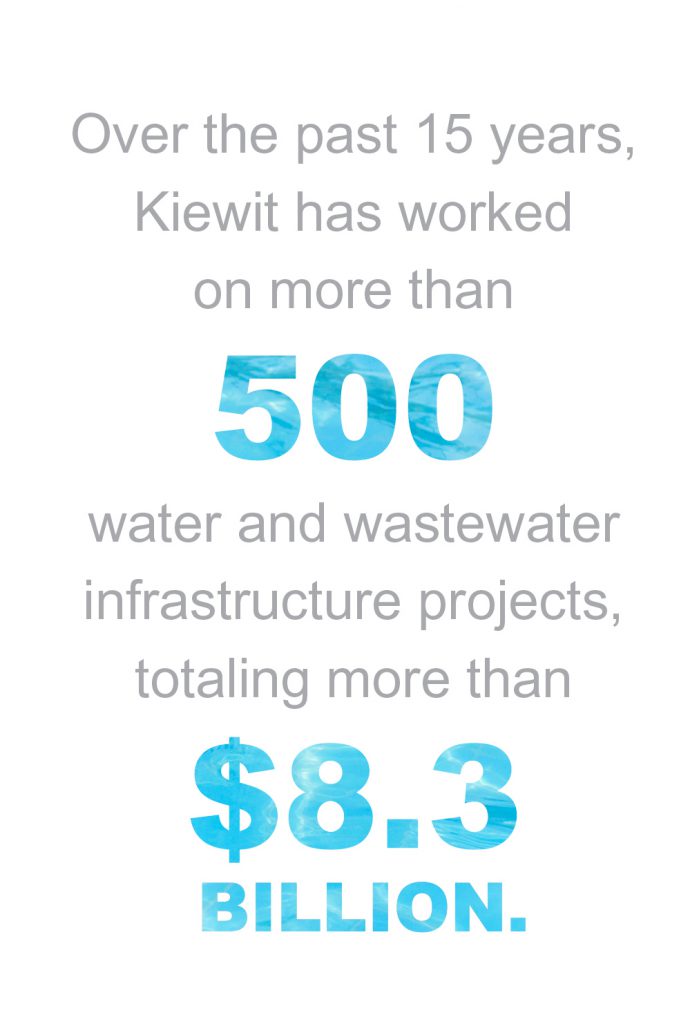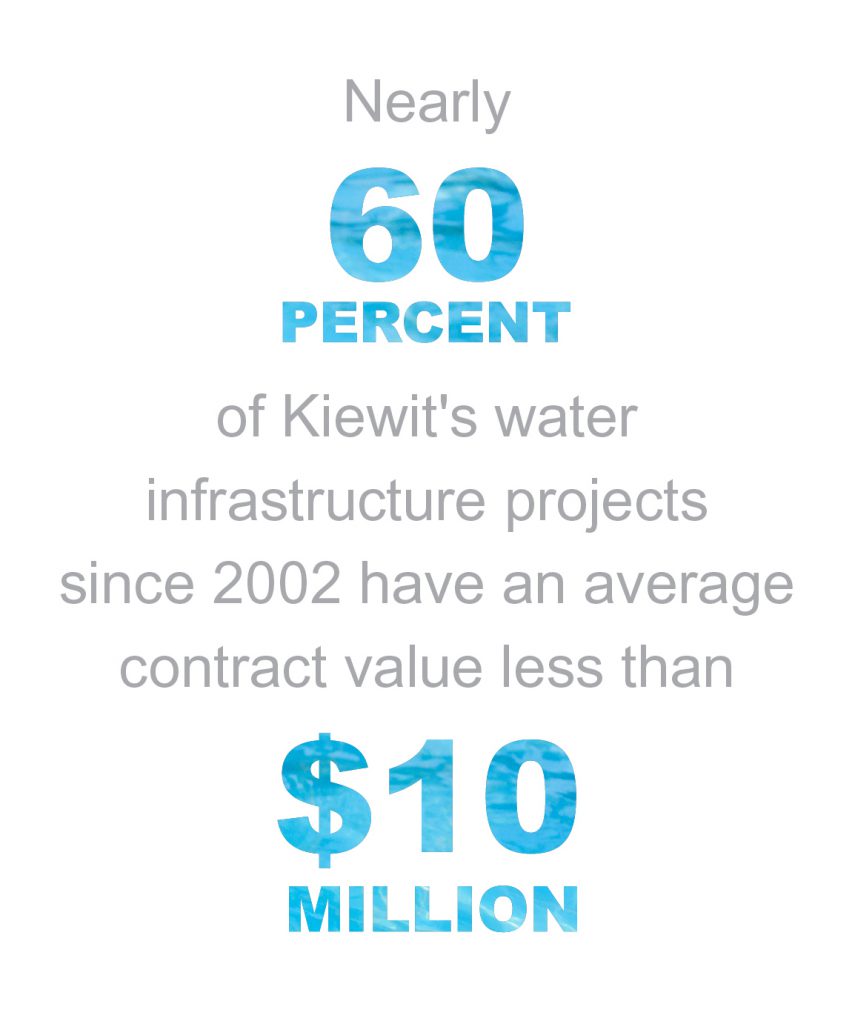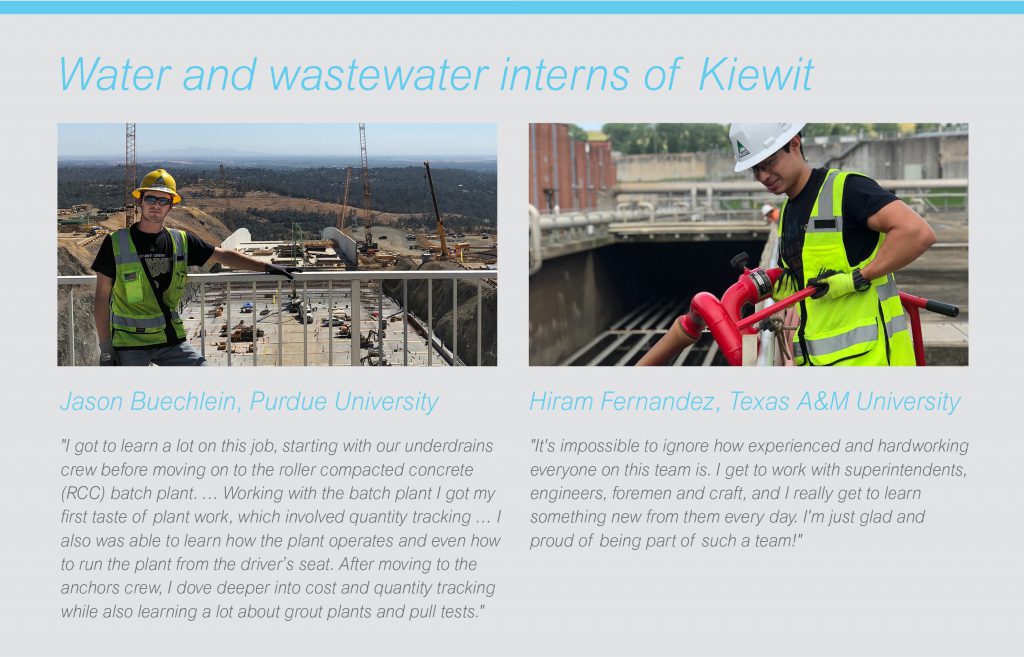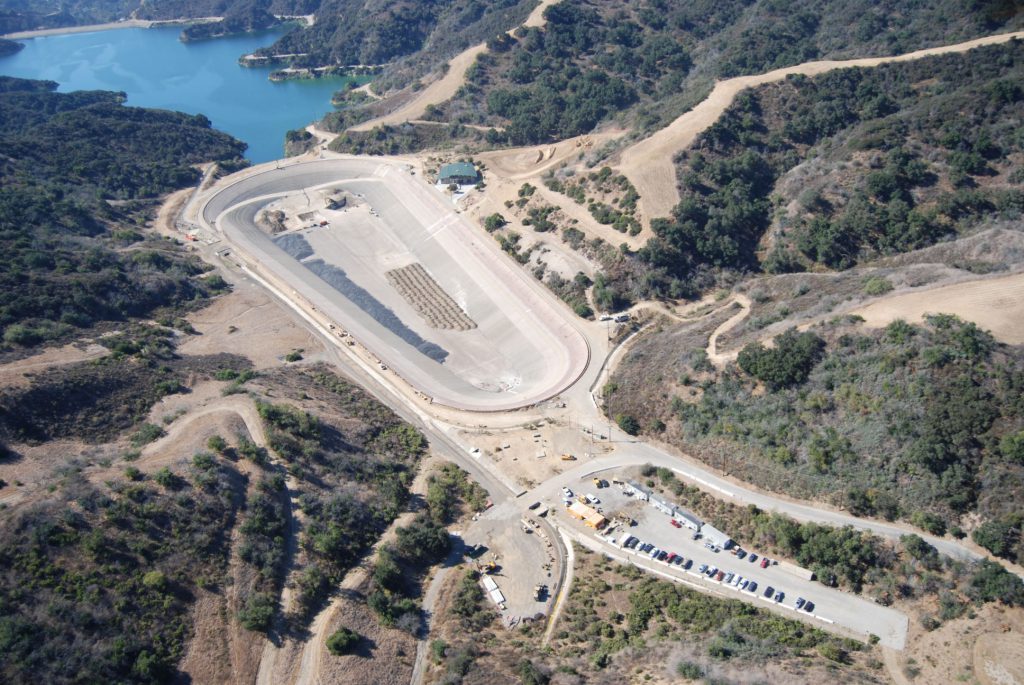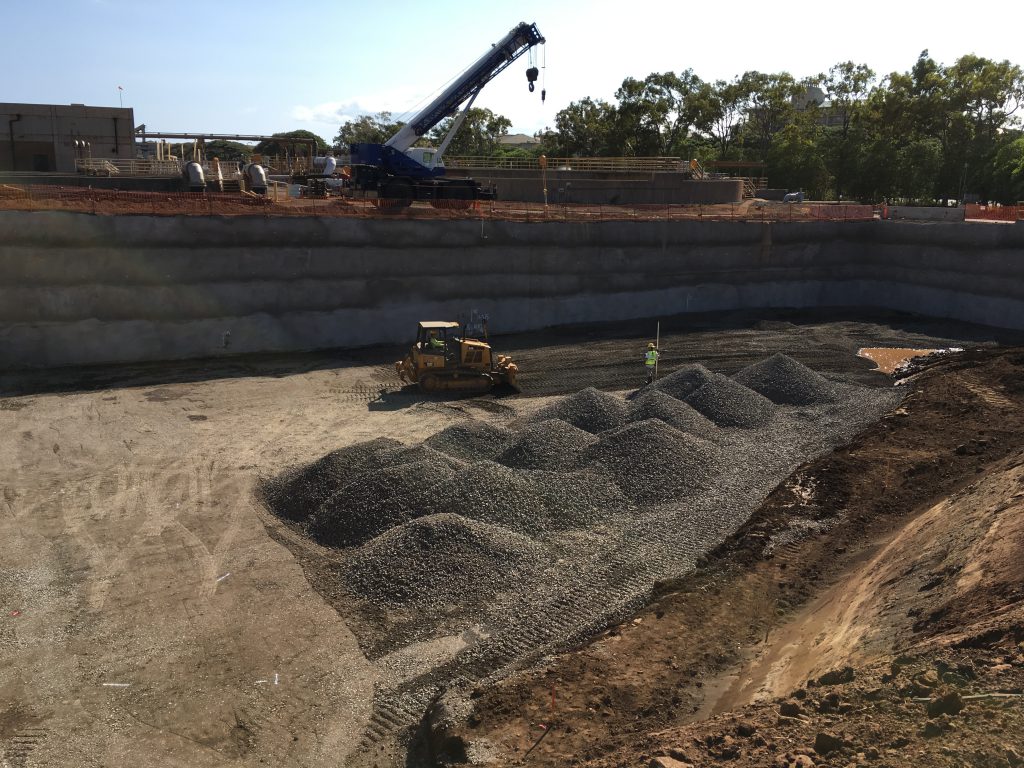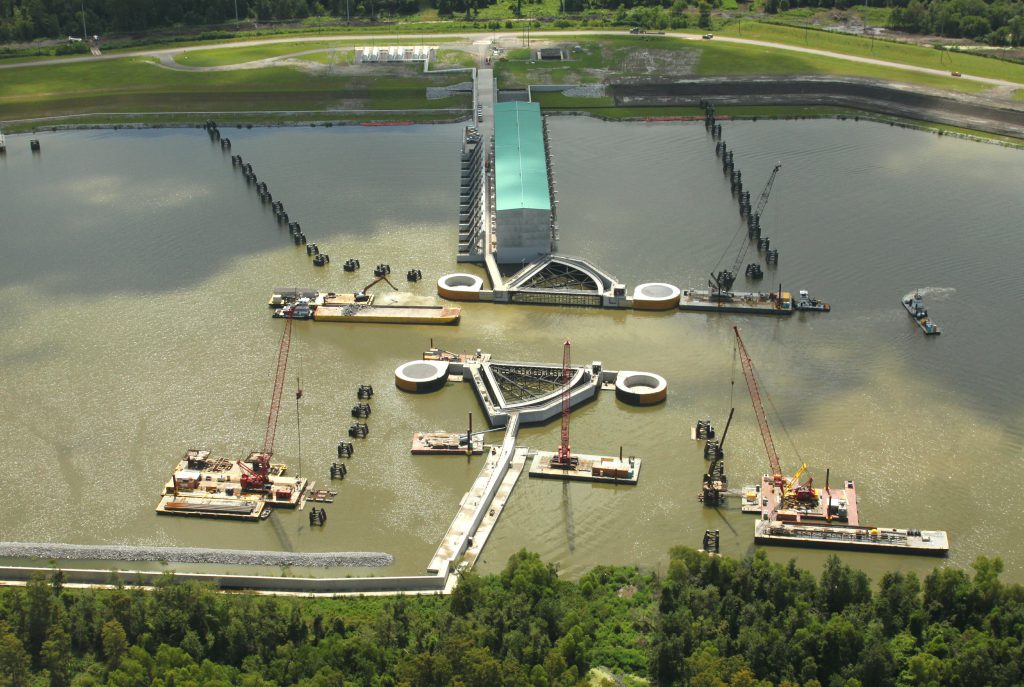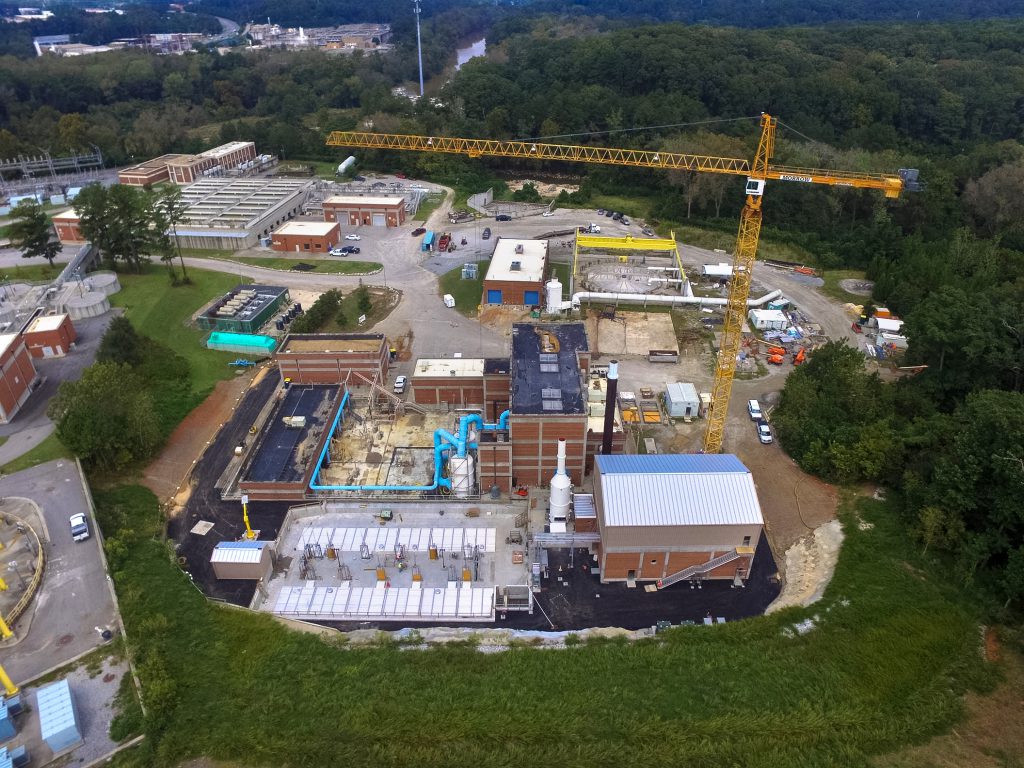Showering. Cooking. Flushing the toilet.
Pollution. Floods. Broken water mains.
Water. It enables life’s most vital daily activities, but left untreated or uncontrolled, causes havoc.
The infrastructure Americans depend on to manage the flow of water into, out of, and away from their communities is in need of repair. On its 2017 Infrastructure Report Card, American Society of Civil Engineers (ASCE) graded American drinking water a D, dams a D and wastewater a D+.
Not only is existing water infrastructure missing the mark, new infrastructure is greatly needed due to population growth and stricter Environmental Protection Agency (EPA) regulations.
With decades of experience in the water infrastructure market, Kiewit companies are helping water municipalities and other state and federal agencies make the grade as the number of these projects climbs across the country. Kiewit employees are improving infrastructure and helping provide people a clean, dependable water supply, and protecting them from water’s potentially devastating impacts.
A rebounding market
When the recession settled in around 2008-2009, the water infrastructure market felt the hit.
“Many water infrastructure projects are often driven by capacity and new development,” said Kiewit Infrastructure West Co. Senior Vice President Matt Scott, who has 25 years of experience working on water and wastewater projects with Kiewit. “Because of the recession, there were fewer new suburbs and houses built, so there wasn’t a need to grow capacity. It also limits the tax base for funding, so a lot of wastewater upgrades were delayed.”
As the economy recovered, so did the water and wastewater project market. According to the Water Design-Build Council (WDBC), “U.S. water and wastewater utilities spend $40 to $50 billion a year to upgrade, rehabilitate, replace and expand their water and wastewater infrastructure.” WDBC anticipates spending will continue to increase, amounting to over $60 billion annually by the end of the next decade.
For Kiewit, which has worked on more than 500 water infrastructure projects in the past 15 years, it’s an exciting time.
From source to tap and back
A lot of infrastructure is needed to treat and deliver drinking water and treat wastewater so that it can be returned back into the ecosystem. When you turn on the tap at home, the water has traveled from a source — a river or even the ocean via a desalination plant — to a treatment facility. It’s then held in a reservoir before it flows through water supply pipes and into your house.
Once the water is used — to wash clothes, brush your teeth or do the dishes — the wastewater travels through sewage pipes and makes its way to a treatment plant to be cleaned before it is put back into the ecosystem along with storm water runoff.
Kiewit people have the experience and skills to build all of the infrastructure involved in the process.
For example:
- In the past five years in California, crews have worked on two desalination plants, 50 miles of water supply pipe and 23 wastewater treatment plants.
- In New York, Kiewit Shea, AJV is working for the New York City Department of Environmental Protection to build a bypass tunnel for the leaking Delaware Aqueduct, which supplies nearly half of New York City’s water.
- Across the Southeast and Mid-Atlantic, crews are focused on working with clients to upgrade water treatment facilities.
Tom Trimble, an area manager with Kiewit Water Facilities South Co., has worked for Kiewit for 26 years and on many water infrastructure projects. He helps manage efforts to pursue and build these projects, which require many different areas of expertise.
“Every treatment plant that we build, whether expansion, new or retrofit, you almost always have demolition, earthwork, concrete, underground pipe, above-ground pipe, mechanical equipment installation, electrical and startup and commissioning,” Trimble said. “You need a staff that’s knowledgeable about all of these types of work and a diverse craft workforce. What makes Kiewit positioned so well in this market is that we have that expertise within our company and can self-perform much of this work and control our own destiny.”
Preventing water’s fury
While some Kiewit teams help bring water into and out of communities, others are making sure it doesn’t harm them.
Residents of New Orleans, Louisiana, and Oroville, California, know all too well how much destruction water can cause when it’s out of control. In 2005, Hurricane Katrina killed more than 1,400 people, many in New Orleans. In 2017, erosion was discovered on the lower chute of the main flood control spillway at Lake Oroville. With an onslaught of winter storms, releases down the damaged main spillway were unable to prevent the reservoir from overtopping the concrete weir. Water cascaded down the emergency spillway, triggering the evacuation of more than 180,000 people downstream of the lake.
After both of these natural disasters, Kiewit helped make repairs.
Partnering with other construction companies, Kiewit completed the Gulf Intracoastal Waterway (GIWW) West Closure Complex and Permanent Canal Closures & Pumps (PCCP) projects, each part of the U.S. Army Corps of Engineers $14.5 billion Hurricane and Storm Damage Risk Reduction System (HSDRRS) following Hurricane Katrina. Collectively, HSDRRS will protect southeast Louisiana from a 100-year level storm surge.
In Oroville, work is ongoing to upgrade the main and emergency spillways. Crews are on schedule to complete the project on time later this year, and the new spillways will feature thicker slabs and walls, drain pipes, and slab anchors.
The existing Upper Stone Canyon Reservoir is being modified to comply with water-quality regulations by placing a 700,000-square-foot floating cover over the reservoir.
Modifications to the Lahaina Wastewater Reclamation Facility in Hawaii must be completed without interrupting plant operations and will increase the facility’s capacity.
Completed to protect the city of New Orleans and the surrounding area from hurricane storm surge, the Gulf Intracoastal Waterway West Closure Complex includes one of the world’s largest interior drainage pump stations and one of the nation’s largest navigable floodgates.
Work that matters
Even as Kiewit delivers more than 30 water infrastructure projects each year, the sense of pride felt by employees never wanes.
Carey Allen, senior vice president and business line manager for Kiewit Water Facilities South Co., has worked for the Kiewit organization for more than 15 years. Being a part of the nation’s efforts to improve infrastructure, and to deliver and treat water safely, is something she takes great pride in.
“It’s really an honor to be part of this work at Kiewit,” Allen said. “To think about all of the tens of thousands of clients in the water industry and all of the populations that need clean drinking water and their wastewater treated, to be part of that process is pretty outstanding.”
